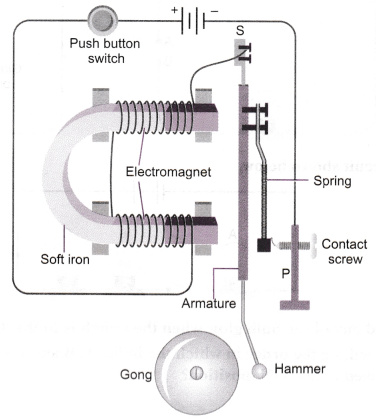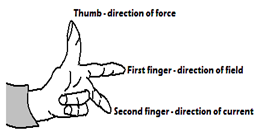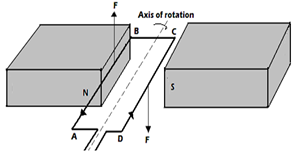Simple Electromagnets
- An electromagnet is made by placing a soft iron core inside a solenoid carrying an electric current. This is shown below.
- The right hand grip rule for a current carrying solenoid can as well be used to predict the polarities of the electromagnet.
Factors Affecting the Strength of an Electromagnet
1. The amount (size) of current in the solenoid
The strength of an electromagnet is directly proportional to the amount of electric current in the
solenoid. Therefore, the larger the current the stronger the electromagnet.
2.The number of turns in the solenoid
The strength of the electromagnet is directly proportional to the number of turns in the solenoid.
Therefore, the more the number of turns the strong the electromagnet.
3.The length of the solenoid
The strength of the electromagnet is directly proportional the length of the solenoid.
Therefore the longer the solenoid the stronger the electromagnet.
4. The shape of the core
Horse shoe shaped core produces a stronger electromagnet than u- shaped core while a
u-shaped core produces a stronger electromagnet than a straight core.
electromagnets are commonly used in making electric bells

Force on a current carrying conductor (The Motor Effect)

- A conductor carrying current placed in a magnetic field experiences a force. This is called the motor effect.
- The magnetic field concentrates at the top of the conductor than at the bottom thereby creating a region of strong field. The reason for this is that the field due to electric current in the conductor and that of the magnets reinforce each other since they are directed in the same direction.
- The relatively weak field at the bottom of the conductor is as result of cancellation between the two fields since they are directed in opposite directions. The resultant force therefore acts on the conductor downwards.
FLEMING'S LEFT HAND RULE
- The direction of force on conductor can be predicted by Fleming’s left hand rule which states that “If the thumb, first and second fingers are held mutually at right angles with the first finger pointing the direction of magnetic field, the second finger in the direction of current, then the thumb points in the direction of force”

For rectangular coil in a magnetic field, one side experiences an upward force and the other
side a downward force and the coil is set into a rotation. Below is an example.


Force between Parallel Straight Current Carrying Conductors
a) Parallel Conductors Carrying Current in Same Direction

The magnetic field between the conductors is weaker due to cancellation than the field from the
outer side. The resultant force on the conductors acts to push them towards each other.
b) Parallel Conductors Carrying Current In Opposite Direction

The fields between the conductors repel each other since they are directed in same direction.
A force, therefore, acts on the conductors to pull them apart (outwards)
Factors Affecting Force on a Conductor Carrying Current in a Magnetic Field
1. Magnitude of electric current-force increases with current
2. Strength of magnetic field – force increases with strength of the magnetic field
3. Length of the conductor in the field – the longer the length the stronger the force
4. Angle the conductor makes with the magnetic field – force increases with the angle. It
is maximum when the conductor is at an angle of 900 with the magnetic field
video tutorial on the Motor rule & Flemming's left hand rule